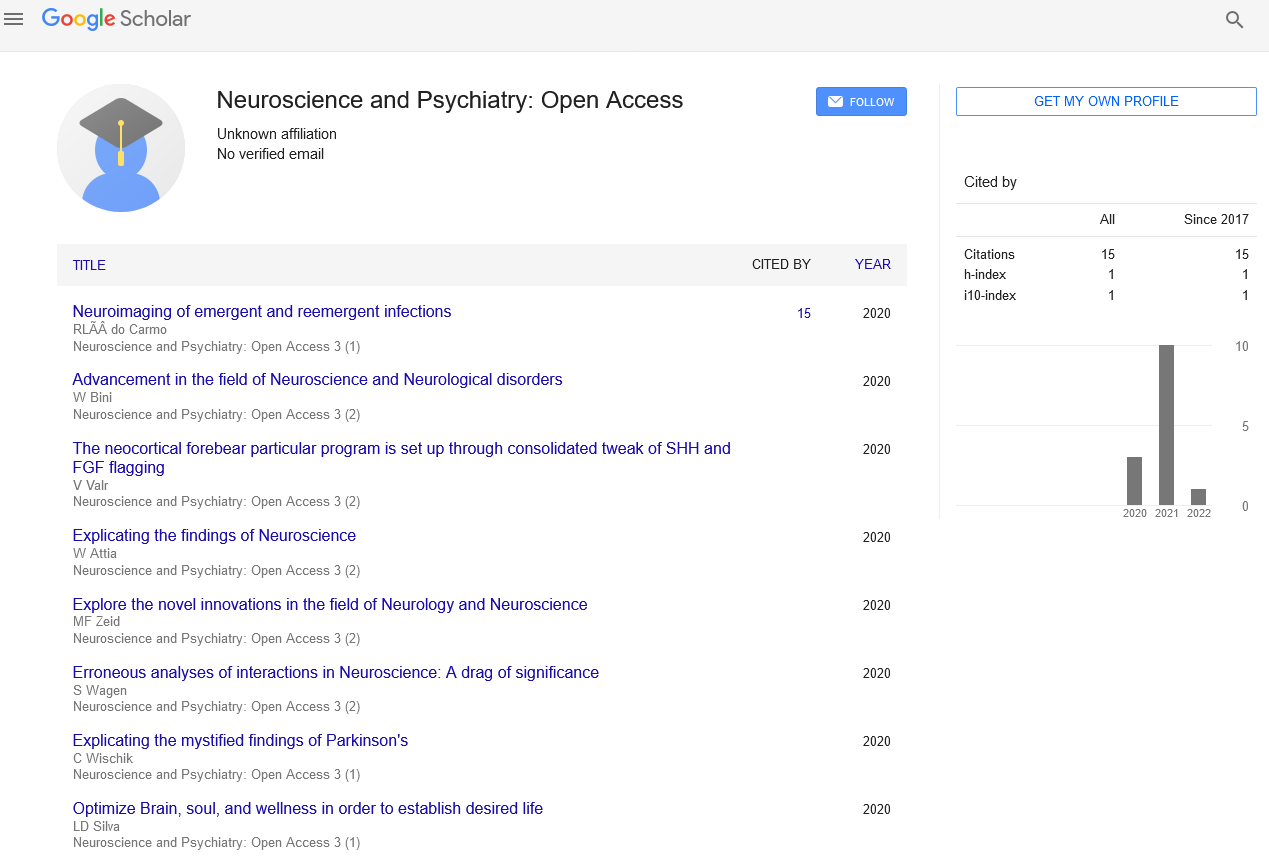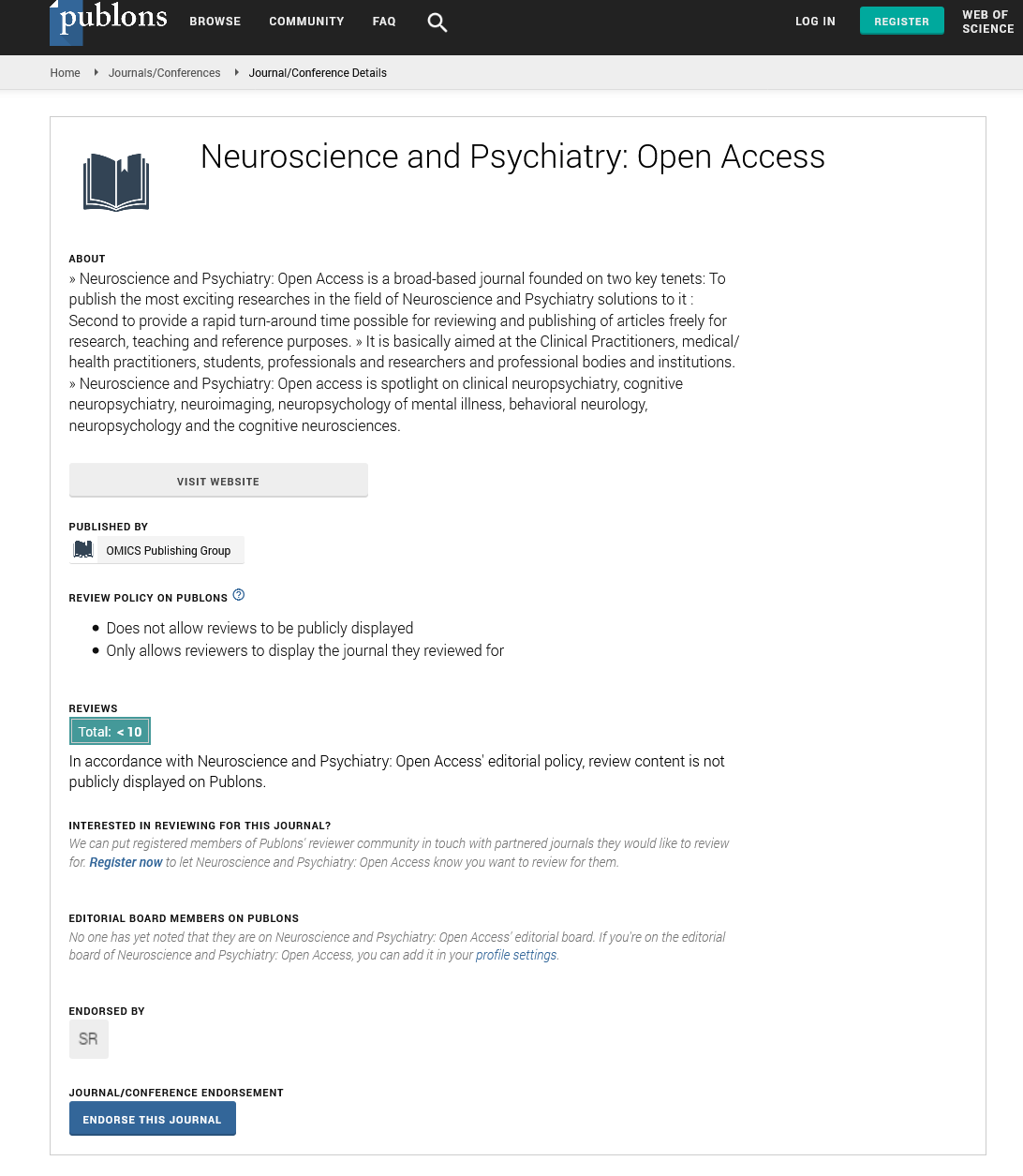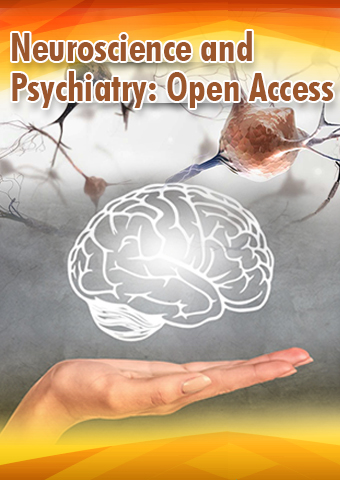Perspective - Neuroscience and Psychiatry: Open Access (2024) Volume 7, Issue 5
The Genetics of Major Depressive Disorder: Current Insights
- Corresponding Author:
- Olivia Dean
Department of Psychiatry,
University of Melbourne,
Melbourne,
Australia
E-mail: olivia.d3@deakin.edu.au
Received: 17-09-2024, Manuscript No. NPOA-24-140613; Editor assigned: 20-09-2024, PreQC No. NPOA-24-140613 (PQ); Reviewed: 04-10-2024, QC No. NPOA-24- 140613; Revised: 14-10-2024, Manuscript No. NPOA-24-140613 (R); Published: 21-10-2024, DOI: 10.47532/npoa.2024.7(5).256-258
Introduction
Major Depressive Disorder (MDD) is a pervasive mental health condition affecting millions worldwide. Characterized by persistent sadness, loss of interest, and various cognitive and physical symptoms, MDD can severely impact daily functioning. While environmental factors and personal experiences play significant roles, there is growing evidence that genetics also contribute to the susceptibility and development of MDD. This article delves into the current insights on the genetics of MDD, exploring genetic markers, family studies, twin studies, gene-environment interactions, and the implications of these findings for treatment and prevention.
Description
Genetic markers and heritability
Oxytocin research into the genetics of MDD has identified several genetic markers associated with the disorder. These markers are often found through Genome-Wide Association Studies (GWAS), which scan the entire genome for small variations that occur more frequently in individuals with MDD than in those without.
Key genetic markers
Several Single Nucleotide Polymorphisms (SNPs) have been linked to MDD. Notably, variations in the serotonin transporter gene (SLC6A4) have been associated with MDD. This gene is involved in the reuptake of serotonin, a neurotransmitter that plays a crucial role in mood regulation. Variants of SLC6A4, particularly the short allele, have been linked to an increased risk of developing MDD, especially in the presence of stressful life events.
Another significant genetic marker is the Brain-Derived Neurotrophic Factor (BDNF) gene, which is involved in neuroplasticity and neuronal survival. Variations in the BDNF gene, such as the Val66Met polymorphism, have been associated with MDD. Individuals carrying the Met allele may have a reduced ability to produce BDNF, potentially leading to impaired neuronal function and resilience to stress.
Heritability estimates
Twin studies have been instrumental in estimating the heritability of MDD. Heritability refers to the proportion of variation in a trait that can be attributed to genetic factors. Twin studies compare the concordance rates of MDD in monozygotic (identical) twins and dizygotic (fraternal) twins. Monozygotic twins share 100% of their genes, while dizygotic twins share about 50%.
These studies suggest that the heritability of MDD is approximately 30-40%. This indicates that while genetics play a significant role, environmental factors also substantially contribute to the risk of developing MDD. The interplay between genes and environment is complex and highlights the importance of considering both factors in understanding and treating MDD.
Family studies
Family studies have provided further evidence for the genetic basis of MDD. These studies examine the prevalence of MDD among relatives of affected individuals. If MDD has a genetic component, we would expect higher rates of the disorder among close relatives compared to the general population.
Findings from family studies
Consistently, family studies have shown that firstdegree relatives (parents, siblings, and children) of individuals with MDD have a higher risk of developing the disorder compared to the general population. The risk is estimated to be two to three times higher for first-degree relatives. This increased risk extends to both unipolar depression and bipolar disorder, suggesting shared genetic factors.
Family studies also reveal that the age of onset and severity of MDD can influence genetic risk. Early-onset MDD (occurring before the age of 20) and severe forms of the disorder tend to have a stronger genetic component. This indicates that individuals with a family history of early-onset or severe MDD may be particularly vulnerable to developing the disorder.
Twin studies
Twin studies provide a powerful method for disentangling the effects of genetics and environment. By comparing concordance rates between monozygotic and dizygotic twins, researchers can estimate the relative contributions of genetic and environmental factors to MDD.
Key findings
As mentioned earlier, twin studies suggest that the heritability of MDD is around 30-40%. Monozygotic twins show higher concordance rates for MDD compared to dizygotic twins. This indicates a significant genetic influence, although the lower than 100% concordance in monozygotic twins underscores the role of environmental factors.
Twin studies also highlight the importance of gene-environment interactions. For example, twins who share the same genetic predisposition but are exposed to different environmental stressors may have different outcomes in terms of developing MDD. This interplay between genetic vulnerability and environmental triggers is crucial for understanding the etiology of MDD.
Gene-environment interactions
Gene-environment interactions (GxE) refer to the dynamic interplay between genetic predispositions and environmental influences. In the context of MDD, certain genetic variations may increase an individual’s sensitivity to environmental stressors, thereby elevating the risk of developing the disorder.
Key studies on GxE
One of the most well-known studies on GxE interactions in MDD is the research on the serotonin transporter gene (SLC6A4) and stressful life events. Individuals with the short allele of the SLC6A4 gene who experience significant life stressors are more likely to develop MDD compared to those with the long allele. This finding illustrates how genetic susceptibility can interact with environmental factors to influence the risk of MDD.
Another example involves the BDNF gene. Research suggests that individuals with the Met allele of the BDNF gene who are exposed to earlylife adversity, such as childhood abuse or neglect, have a higher risk of developing MDD later in life. These findings underscore the importance of considering both genetic and environmental factors in understanding the etiology of MDD.
Implications for treatment and prevention
Understanding the genetic underpinnings of MDD has significant implications for treatment and prevention. Personalized medicine approaches that consider an individual’s genetic profile can improve the efficacy of treatments and reduce the risk of adverse effects.
Pharmacogenomics
Pharmacogenomics is the study of how genes influence an individual’s response to drugs. In the context of MDD, pharmacogenomic testing can help identify genetic variations that affect the metabolism and efficacy of antidepressant medications. For example, variations in the Cytochrome P450 enzymes (CYP450) can influence how individuals metabolize certain antidepressants. By tailoring treatment based on genetic information, healthcare providers can optimize medication choices and dosages, enhancing treatment outcomes.
Early intervention and prevention
Identifying individuals with a genetic predisposition to MDD can facilitate early intervention and prevention efforts. For example, individuals with a family history of MDD or known genetic risk factors can benefit from targeted interventions, such as stress management programs, Cognitive-Behavioral Therapy (CBT), and lifestyle modifications. Early intervention can help mitigate the impact of environmental stressors and reduce the likelihood of developing MDD.
Future directions
The field of psychiatric genetics is rapidly evolving, and future research holds promise for further elucidating the genetic basis of MDD. Advances in technology, such as next-generation sequencing and large-scale biobanks, will enable more comprehensive and detailed analyses of the genetic architecture of MDD.
Potential areas of research
Future research may focus on identifying rare genetic variants with large effects, exploring the role of epigenetics in MDD, and investigating the interplay between multiple genes and environmental factors. Additionally, integrating genetic data with other biological markers, such as neuroimaging and biomarkers of inflammation, may provide a more holistic understanding of MDD.
Conclusion
The genetics of Major Depressive Disorder (MDD) provide valuable insights into the etiology and potential treatment of this complex condition. Genetic markers, heritability estimates, family studies, twin studies, and geneenvironment interactions all contribute to our understanding of the genetic underpinnings of MDD. Advances in genetic research have the potential to improve diagnosis, personalize treatment, and inform prevention strategies. As research progresses, a more comprehensive understanding of the genetic and environmental factors contributing to MDD will likely emerge, offering hope for better outcomes for individuals affected by this debilitating disorder.


